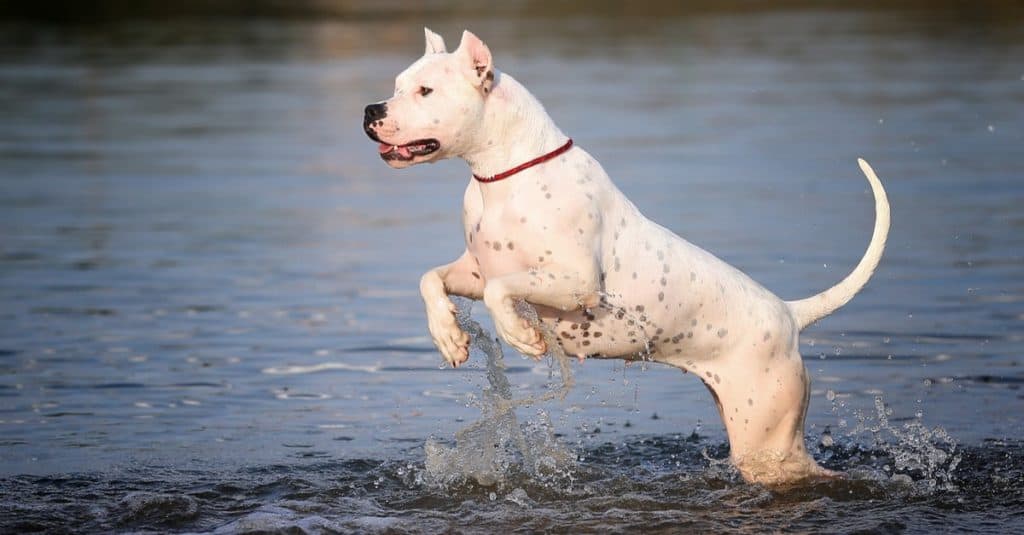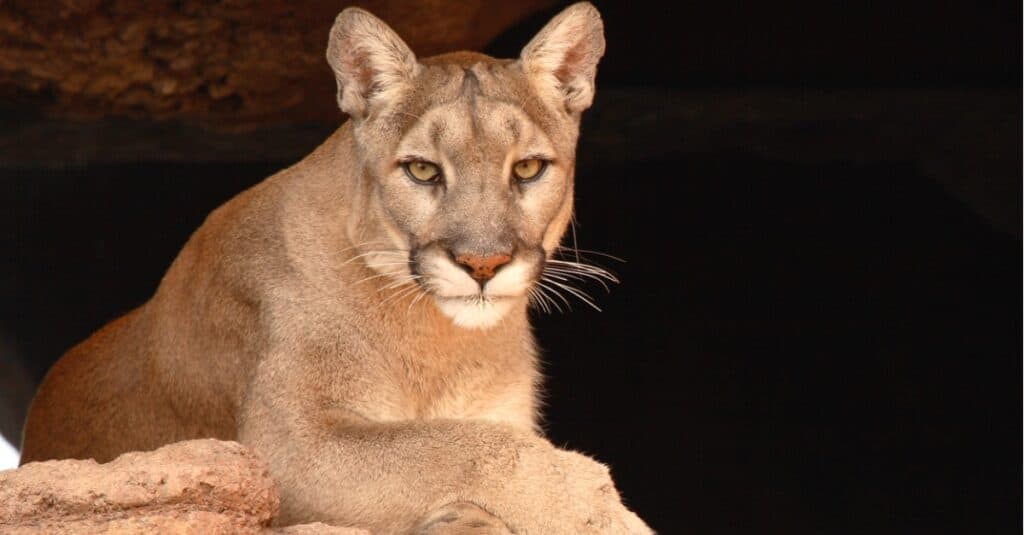On April 2nd, 2020 a video was shared by Animal Planet that showed a Dogo Argentino defending two young girls from a puma, or mountain lion. After a struggle, the Dogo Argentino dispatched the mountain lion. This video has created considerable online discussion about the breed. After all, pumas are apex predators in their habitats, so it’s surprising a dog would be able to defend itself so well. Let’s dive into the differences between Dogo Argentinos and pumas and how these dogs are able to stand their ground against such a large predator.
Comparing a Dogo Argentino and a Puma

| Dogo Argentino | Puma | |
|---|---|---|
| Size | Weight: 88-100lbs Length: 3ft-3.5ft Height: 2-2.2ft at the shoulder | Weight: 148lbs-232lbs on average Length: 5ft-8ft Height: 2ft-3ft at the shoulder |
| Speed | – 25 mph | – 30-40 mph |
| Defenses | – Size – Threat display of growling and barking – May be trained to work in packs | – High speed – Large size – Good senses – Ability to hide and use fur as camouflage |
| Offensive Capabilities | – 500 PSI bite – Great stamina to carry out long fights – Powerful legs help the dog bite and then drag prey | – Powerful biting force of 1311N, over 400 PSI – Moderately powerful jaws – 2-inch-long canines – 2.5-inch claws |
| Predatory Behavior | – Often trained to hunt other larger animals in packs – Not true predators because they are domesticated | – Ambush predator that wraps its forelegs around prey and takes them to the ground – Very quiet hunters that stalk potential prey before attacking |
What Are Key Differences Between a Dogo Argentino and a Puma?

Pumas are deadly ambush predators despite not being the largest of the big cats.
©iStock.com/Kara Capaldo
The greatest differences between a Dogo Argentino and a puma are morphological and size-based. The Dogo Argentino is a large canine with an unusually muscular body, strong rear legs, and a large head weighing up to 100lbs and standing 2.2ft at the shoulder, and a puma is a large feline with powerful front legs that weighs up to 232lbs and stands up to 3ft tall at the shoulder.
These large animals represent some of the most powerful members of the canine and feline families. A cursory look at their most significant differences is not enough to determine which animal is most likely to win a fight between the two. Let’s look a little closer.
What Are the Key Factors Between a Dogo Argentino and a Puma?

The Dogo Argentino is a very strong and protective creature.
©Ershov_Andrey/Shutterstock.com
Analyzing how a Dogo Argentino and puma stack up against one another requires a close look at multiple factors. Specifically, we need to know the size, power, and attacking methods of each animal. We’re going to compare five aspects of these creatures and determine who has the power and tenacity to take down the other animal.
Dogo Argentino vs Puma: Size
Pumas are larger than Dogos Argentinos. The Dogo Argentino is a rather large animal that can weigh up to 100lbs and stand 2.2ft at the shoulder. This is not the largest dog in the world by any measure. It’s compact, too, measuring just 3.5ft in length. The dog’s size does not diminish its power, though.
A puma weighs between 148lbs and 232lbs on average, but they can get even larger. These animals can stand up to 3ft at the shoulder and grow 8ft long, counting their tail length.
Pumas have the size advantage against the Dogo Argentino.
Dogo Argentino vs Puma: Speed and Movement
The Dogo Argentino is a fast hunting dog that is capable of chasing at a top speed of about 25 mph. However, pumas are much faster, running between 30-40 mph when they are closing in on their prey and perhaps up to 50 mph.
Pumas have a speed advantage against the Dogo Argentino.
Dogo Argentino vs Puma: Defenses
Pumas have great physical defenses. For example, they can quickly run away from predators, climb trees to escape danger, and silently stalk their ranges. Their fur can even act as camouflage in some cases.
The Dogo Argentino uses its large size and threat display of barking and growling to make predators back away. Moreover, these animals may be trained to hunt in packs.
As an individual, pumas have superior defenses to Dogos Argentinos.
Dogo Argentino vs Puma: Offensive Capabilities
Pumas are very powerful animals that use a multifaceted approach to attacking. They prefer to ambush prey and then attack with a single bite to the neck or head. If that fails, they will continue to bite and claw their prey with 400 PSI bites and 2-inch-long canine teeth. Overall, a puma’s attack is very strong, but it works best when the fight ends quickly.
The Dogo Argentino may have a more powerful bite than a puma, but its bite is all it has in terms of ways to deal damage. Still, the dog has very powerful legs that help it control prey along with high endurance and stamina. The dog is illegal to own in many parts of the world.
Overall, the puma has an offensive power advantage.
Dogo Argentino vs Puma: Predatory Behavior
The Dogo Argentino retains a prey drive like many animals, but it is a domesticated animal. The breed has been bred to be a pack-hunting game for the pursuit of animals such as wild boar and pumas.
However, pumas are ambush predators that attack from a position of hiding, stalking their prey until they’re close enough to lunge. Next, they’ll wrap their forelegs around prey, bring them to the ground, and deliver a deadly bite to the throat or head.
What happens in an altercation between pumas and a Dogo Argentino?

While Dogo Argentinos were bred to hunt boars and big game, today they’re a breed recognized by the AKC and popular with families.
©iStock.com/gatito33
As we noted earlier, there has been recent video of a Dogo Argentino that was able to defend against a puma. That said, we’ve also emphasized the breed was meant to hunt larger game in packs and any altercation between a Dogo Argentino and a puma could lead to a minimum of serious harm to the dog.
While the Dogo Argentino’s were bred to hunt big game, today the breed is known for being extremely loyal and courageous with owners. The breed was first recognized by the AKC on January 1, 2020. They’re especially popular in locations like Florida and Texas as family dogs.
What Animal Can Take Down a Puma?

The
jaguar
‘s muscular, compact build and those powerful jaws mean that it would be more than a match for a puma
©Pedro Helder Pinheiro/Shutterstock.com
The Jaguar: While a puma would most likely emerge the victor against the stalwart pale-coated canine that is the doggo argentino, it would have a far tougher time squaring up against an adversary known to have the most powerful jaws of any feline, not to mention a compact, solid build. Enter the jaguar Panthera onca, the third-largest feline on the planet and the largest in the Americas.
Compared to the puma’s maximum weight of 232 lbs and a length of 7 feet, the jaguar is capable of tipping the scales at 348 lbs. The fact that it is just 6 feet in length, is merely a function of its compact build.
More powerfully built than the puma, and more heavily muscled, it is more likely to deliver especially devastating blows to its opponent; there is also that bite force of 1,500 psi — more than twice the puma’s which is 725 psi. All things considered, it would be far more prudent for the puma to maintain its elusive nature in the presence of South America’s true apex predator.
The photo featured at the top of this post is © iStock.com/Gerdzhikov
Thank you for reading! Have some feedback for us? Contact the AZ Animals editorial team.






